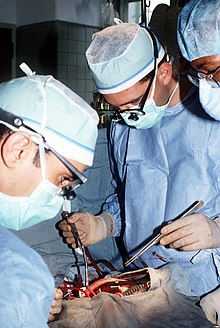Surgical mask

A surgical mask also known as a procedure mask is intended to be worn by health professionals during surgery and at other times to catch the bacteria shed in liquid droplets and aerosols from the wearer's mouth and nose.
Outside health care facilities, simple, inexpensive masks of similar appearance are commonly worn in heavily populated centres in East Asia to help prevent spreading the common cold. In Japan, it is common to wear a face mask while sick to avoid infecting others in public settings.[1]
Surgical masks were widely used in China, Hong Kong, Vietnam, and Toronto, Canada during outbreaks of the SARS virus, during the 2007 avian bird flu pandemic in Japan, and more recently in the United States and Mexico City during the 2009 H1N1 flu outbreak, also known as the swine flu.
Modern surgical masks are made from paper or other non-woven material, and should be discarded after each use.[2]
Effectiveness
Simple surgical masks protect wearers from being splashed in the mouth with body fluids. They also remind wearers not to touch their mouth or nose, which could otherwise transfer viruses and bacteria after having touched a contaminated surface (fomite). They can also reduce the spread of infectious droplets (carrying bacteria or viruses) that are created when the wearer coughs or sneezes. They are not designed to protect the wearer from inhaling such particles. They will trap some particles but are much less effective than respirators, which are designed for this purpose.
Safety guidelines for healthcare workers recommend the wearing of a face-fit tested respirator mask conforming to United States standard NIOSH N95 or European standard EN 149 FFP3 in the vicinity of pandemic-flu patients, to reduce the exposure of the wearer to potentially infectious aerosols and airborne liquid droplets.[3][4]
The CDC summary page, N95 Factsheet, provides additional information on manufacturers' products, as well as the importance of correct fitting of such masks (respirators). The printable factsheet has been designed for issue to those unacustomed to respirator use.
In its guidance regarding the 2009 swine flu outbreak, the U. S. Centers for Disease Control and Prevention (CDC) said:[5]
Information on the effectiveness of facemasks and respirators for the control of influenza in community settings is extremely limited. Thus, it is difficult to assess their potential effectiveness in controlling swine influenza A (H1N1) virus transmission in these settings. ...
If used correctly, facemasks and respirators may help reduce the risk of getting influenza, but they should be used along with other preventive measures, such as avoiding close contact and maintaining good hand hygiene.
In popular culture
- In Japan, it is common to see these masks worn as a show of consideration for others and social responsibility.[6]
- The mythological figure Kuchisake Onna is commonly seen with a surgical mask to hide the scars on her mouth.
- Pop star Michael Jackson often wore a surgical mask out in public to conceal his identity
References
- ^ Japan's war on germs and smells, BBC Online
- ^ Interim Recommendations for Facemask and Respirator Use to Reduce Novel Influenza A (H1N1) Virus Transmission, Centers for Disease Control and Prevention, May 27, 2009: "Unless otherwise specified, the term "facemasks" refers to disposable facemasks cleared by the U.S. Food and Drug Administration (FDA) for use as medical devices. This includes facemasks labeled as surgical, dental, medical procedure, isolation, or laser masks... Facemasks should be used once and then thrown away in the trash."
- ^ Interim guidance on planning for the use of surgical masks and respirators in health care settings during an influenza pandemic, U.S. Department of Health & Human Services, www.pandemicflu.org, October 2006
- ^ Working with highly pathogenic avian influenza virus, UK Health and Safety Executive
- ^ Interim Recommendations for Facemask and Respirator Use in Certain Community Settings Where H1N1 Influenza Virus Transmission Has Been Detected, Centers for Disease Control and Prevention, May 1, 2009
- ^ For allergy season, Japan turns to surgical masks
